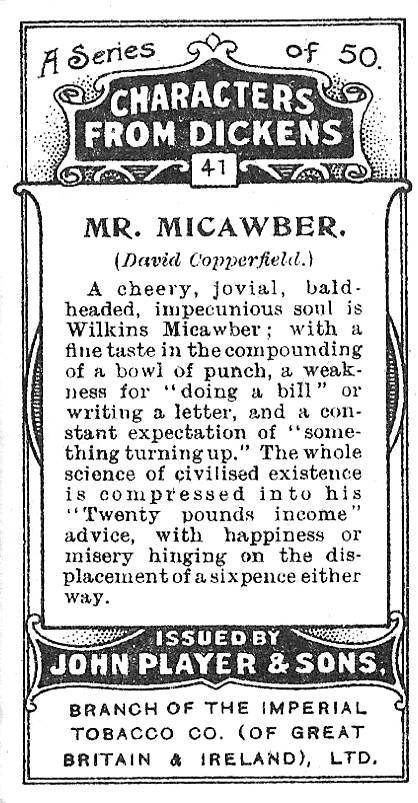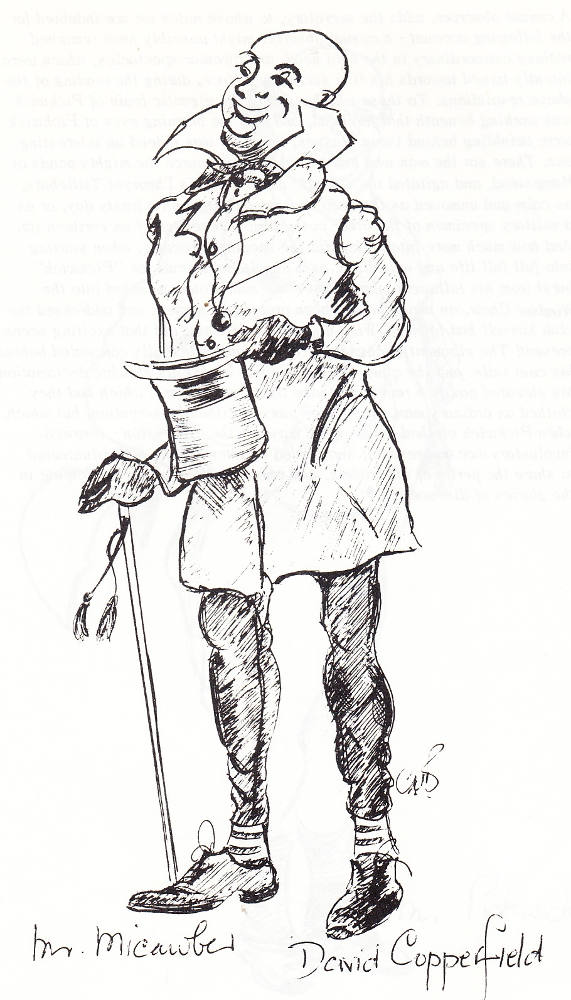

Wilkins Micawber by J. Clayton Clarke (“Kyd”) for the watercolour series (1910): reproduced on John Player cigarette card no. 41: Ninety-two Characters from Dickens: David Copperfield. 2 ½ inches high by 1 ¼ inches wide (6.3 cm high by 3.3 cm wide). [Click on the images to enlarge them.]
MR. MICAWBER (David Copperfield.)
A cheery, jovial, bald-headed, impecunious Wilkins Micawber; with a fine taste in the compounding of a bowl of punch, a weakness for "doing a bill" or writing a letter, and a constant expectation of “something turning up.” The whole science of civilised existence is compressed into his “Twenty pounds income” advice, with happiness or misery hinging on the displacement of a sixpence either way. [Verso of Card No. 41]
Passage Realised: The Essence of "Shabby-Genteel" Wilkins Micawber, Windsor Terrace

The counting-house clock was at half past twelve, and there was general preparation for going to dinner, when Mr. Quinion tapped at the counting-house window, and beckoned to me to go in. I went in, and found there a stoutish, middle-aged person, in a brown surtout and black tights and shoes, with no more hair upon his head (which was a large one, and very shining) than there is upon an egg, and with a very extensive face, which he turned full upon me. His clothes were shabby, but he had an imposing shirt-collar on. He carried a jaunty sort of a stick, with a large pair of rusty tassels to it; and a quizzing-glass hung outside his coat, — for ornament, I afterwards found, as he very seldom looked through it, and couldn’t see anything when he did.
‘This,’ said Mr. Quinion, in allusion to myself, ‘is he.’
‘This,’ said the stranger, with a certain condescending roll in his voice, and a certain indescribable air of doing something genteel, which impressed me very much, ‘is Master Copperfield. I hope I see you well, sir?’ [Household Edition, Chapter XI, "I Begin Life on My Own Account, and Don’t Like It," 78]
Commentary

David's recollection of Micawber's showing him the vibrant street life of the metropolis: Mr. Micawber, impressing the names of streets and shapes of corner houses upon me as we went along, that I might find my way back easily in the morning." by Fred Barnard for the 1872 Household Edition (Ch. XI).
In Kyd's sequence of fifty cards, fully 13 or over 25% concern a single novel, The Pickwick Papers, attesting to the enduring popularity of the picaresque comic novel. The series, however, includes a total of six character cards from the cast of David Copperfield (May 1849 through November 1850), or 12% of the total: the affable master of English rhetoric Wilkens Micawber, no. 41; the oppressed child who becomes a novelist, David Copperfield, no. 39; the rigid and mean-spirited stepfather, Mr. Murdstone, no. 37; the crotchety but warm-hearted independent woman of property Betsey Trotwood, no. 36; the devious, unctuous clerk Uriah Heep, no. 38; and the stalwart pater familias Dan' Peggotty, no. 40 — characterisations generally based on the original serial illustrations of Dickens's regular visual interpreter in the 1840s, Phiz, who produced forty steel-engravings and the wrapper design for the Bradbury and Evans nineteen-month serial, as well as a wood-engraved frontispiece of Little Em'ly and David as children on the Yarmouth sands for the first Cheap Edition (1858) and two vignettes for the two-volume Library Edition: Little Em'ly and David by the Sea and Mr. Peggotty's Dream Comes True. However, Phiz's "fashionable ne'er-do-well" who is constantly talking about something "turning up" owes as much in terms of physiognomy to Fred Barnard's Household Edition composite woodblock illustrations as he does to Phiz's serial engravings.

David's recollection of Micawber's rhetorical excesses: Mr. Micawber delivers some valedictory remarks by Phiz for the April 1850 serial number (Chapter XXXVI, "Enthusiasm").
Although he cannot capture his most humorous aspect, his distinctive voice, Kyd's portrayal of Micawber from David Copperfield admirably conveys his characteristic shabby-genteel appearance. Micawber is often depicted with a top hat, monocle, and an air of optimistic, albeit often misplaced, confidence. Kyd's pair of Micawber illustrations are part of a larger body of work by various artists interpreting Dickens' characters. Other notable illustrators include Hablot Knight Browne ("Phiz"), Fred Barnard, Sol Eytinge, Jr., and Harry Furniss. Each artist brings his own perspective to the humorous character of Micawber, often emphasizing different aspects of his personality and attire for humorous effect. Key aspects of Kyd's Micawber are these:
- Shabby-genteel appearance: Kyd's Micawber is often shown with a slightly worn but still refined style, reflecting his financial struggles and his attempts to maintain a respectable facade.
- Optimism and grand pronouncements: Micawber is known for his optimistic outlook and his tendency to make grandiose statements, even when facing difficult circumstances. This attitude is reflected in Kyd's Player's Cigarette Card No. 41.
- Dynamic poses and expressions: Kyd's Micawber has a dynamic pose and expressive facial features which capture his lively and sometimes over-the-top personality.

David's recollection of Micawber's standing in front of his residence on Windsor Terrace, London, in Chapter XI: Mr. Micawber by Fred Barnard for the third series of Character Sketches (1885).
Although Kyd's representations are largely based on the original illustrations by Hablot Knight Browne (Phiz), the modelling of the figures is suggestive of those of celebrated Dickensian illustrator Fred Barnard for the Household Edition volume 3 (1871). Kyd's model for the bon vivant and perpetual sponger who makes good in Australia was likely Phiz's study of the nattily dressed Wilkins Micawber in Mr. Micawber delivers some valedictory remarks (April 1850: Chapter 36). However, Kyd had no shortage of models for the genial indigent wearing gloves, spats, top hat, and the sort of ostentatious, floral "D'Orsay" waistcoat favoured by young adult David Copperfield and young novelist Charles Dickens, since Micawber occurs in a total of six of Phiz's original serial plates, most significantly perhaps as the loving husband restored to the bosom of his doting family after he has denounced Uriah Heep in Restoration of mutual confidence between Mr. and Mrs. Micawber (September 1850: Chapter 52). The illustrator actually affected the sartorial style of Micawber with spats, gloves, and top-hat, so that he likely had studied the Micawber illustrations of Fred Barnard for the Household Edition volume 3 (1872), particularly the full-page wood engraving depicting Micawber and David passing Finsbury Park, Mr. Micawber, impressing the names of streets and shapes of corner houses upon me as we went along, that I might find my way back easily in the morning" (Chapter XI, "I Begin Life on my Own Account, and Don't Like It"). In all likelihood, Kyd never saw an 1867 Diamond Edition volume of the novel, and therefore was not influenced by Sol Eytinge, Junior's Mr. Micawber and His Family, whose image in that family grouping is in any event quite consistent with Phiz's original.

In addressing the visual features and appurtenances of the irrepressible Wilkins Micawber, including the jaunty cane with rusty tassels, Kyd, like Barnard in the previous decade, could not depart radically from the notions of that character imparted to an earlier generation of readers by Phiz. In the 1849-50 serialisation, the initial illustrator had given Dickens's readers an indelible image: a nattily albeit shabbily dressed middle-aged bourgeois of above average height with a cane, monocle or "quizzing glass" suggestive of the fashions and manners of the Regency, high starched collar, tail-coat, bald head and beaver, a genial expression and a slightly protuberant stomach, beak-like nose, and spindly legs, their thinness accentuated by his close-fitting tights. Barnard produced a total of four images congruent with these Phiz-established features. Another image that perhaps influenced Kyd is that of the fashionably attired urbanite in a London street in the early business hours in one of Fred Barnard's 1885 Character Sketches from Dickens, Mr. Micawber in the third series, widely reproduced, especially in America, where British authors and illustrators did not enjoy full copyright protection at the time.
Inept though he may be in financial matters, the ever-optimistic Wilkins Micawber is David's friend and mentor, an idealized version of the author's own father, the mercurial and perpetually debt-ridden John Dickens. Although he does not appear early in the serial, Micawber is an abiding presence as soon as David is consigned to the wine-bottling warehouse of Murdstone and Grinby that stands in for Dickens's own childhood horror, the blacking warehouse at Hungerford Stairs. With the classic ticks ("Something is bound to turn up") and verbal mannerisms of a secondary Dickens character, Micawber becomes a comic voice of epic proportions, one of Dickens's greatest comic achievements. Kyd's character study and cigarette card both capture Micawber's spriteliness, synthesizing the original caricature and the more realistic modelling of the Barnard images.
Relevant Illustrated Editions of this Novel (1849 through 1910)
- David Copperfield (homepage)
- Phiz's 40 serial illustrations for David Copperfield (May 1849 - November 1850)
- O. C. Darley's Frontispiece in the New York edition (Vol. 1, 1863)
- O. C. Darley's Frontispiece in the New York edition (Vol. 2, 1863)
- Sir John Gilbert's Frontispiece in the New York edition (Vol. 3, 1863)
- O. C. Darley's Frontispiece in the New York edition (Vol. 4, 1863)
- Sol Eytinge, Junior's 16 wood engravings for the Diamond Edition (1867)
- Fred Barnard's 62 Composite Woodblock Engravings for the Household Edition (1872)
- W. H. C. Groome's seven lithographs for the Collins Clear-type Pocket Edition (1907)
- Harry Furniss's Twenty-nine lithographs for the Charles Dickens Library Edition (1910).
Scanned images and text by Philip V. Allingham. [You may use these images without prior permission for any scholarly or educational purpose as long as you (1) credit the person who scanned the images and (2) link your document to this URL in a web document or cite the Victorian Web in a print one.]
Bibliography
Barnard, Fred. A Series of Character Sketches from Dickens, in Colour from the Original Drawings by Frederick Barnard Barnard. [Series 3: Wilkins Micawber; Miss Betsey Trotwood; Captain Edward CuttleMrs. Gamp, The Two Wellers, Mr. Pecksniff, Caleb Plummer and His Blind Daughter, Captain Cuttle; Uriah Heep; Dick Swiveller; and Bob Cratchit and Tiny Tim]. London: Cassell, Petter, and Galpin, 1885.
Bentley, Nicolas, Michael Slater, and Nina Burgis. The Dickens Index. Oxford and New York: Oxford U. P., 1988.
Brigden, C. A. T. "No. 7. Mr. Micawber," David Copperfield. The Characters from Charles Dickens as depicted by Kyd. Rochester, Kent: John Hallewell, 1978.
The Characters of Charles Dickens Pourtrayed in a Series of Original Water Colour Sketches by “Kyd.” London, Paris, and New York: Raphael Tuck & Sons, 1898[?].
Davis, Paul. Charles Dickens A to Z: The Essential Reference to His Life and Work. New York: Checkmark and Facts On File, 1999.
Dickens, Charles. The Personal Experience and History of David Copperfield. Illustrated by Hablot Knight Browne. London: Chapman and Hall, 1851.
_______. David Copperfield. Illustrated by Hablot Knight Browne ("Phiz"). The Centenary Edition. 2 vols. London and New York: Chapman & Hall, Charles Scribner's Sons, 1911.
_______. The Personal Experience and History of David Copperfield. Works of Charles Dickens. Household Edition. 55 vols. Illustrated by F. O. C. Darley and John Gilbert. New York: Sheldon and Co., 1863.
_______. David Copperfield. Illustrated by Sol Eytinge, Jr, and engraved by A. V. S. Anthony. 14 vols. Boston: Ticknor & Fields, 1867. IV.
_______. David Copperfield, with 61 illustrations by Fred Barnard. Household Edition, 22 vols. London: Chapman and Hall, 1877. Volume XV.
_______. David Copperfield. Illustrated by Harry Furniss. The Charles Dickens Library Edition. 18 vols. London: Educational Book, 1910. Vol. 10.
Hammerton, J. A. "Ch. XVII. David Copperfield." The Dickens Picture-Book. London: Educational Book Co., [1910]. 339-438.
Kyd. Characters from Dickens. Nottingham: John Player & Sons, 1910.
Steig, Michael. Chapter 5. "David Copperfield: Progress of a Confused Soul." Dickens and Phiz. Bloomington & London: Indiana U. P., 1978. 113-130.
Created 14 January 2015
Last modified 22 July 2025